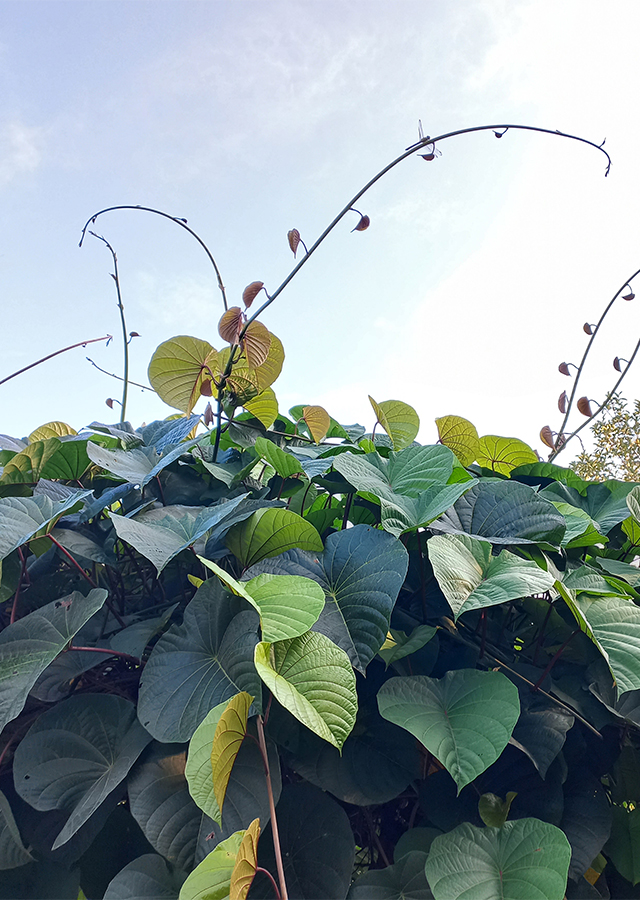Traditional Herbs from Decalobanthus peltatus
wound
- Prepare enough ripe leaves then wash them with running water until clean.
- Crush the leaves until they become a paste.
- Apply the leaf paste on the injured skin.
radang_inus_buntu
- Take the leaves cooked\u00a0then wash until clean.
- Boil until boiling.
- Let stand until warm/cold.
- Strain then drink.
What is Decalobanthus peltatus Looks like??



Parts of Decalobanthus peltatus that could be used
- Leaves
- Roots
- Sap
- Stems
Decalobanthus peltatus Distribution
Mantangan is a local plant species native to Asia. It has a wide distribution, stretching from East Africa through the Indian Ocean, South and Southeast Asia to many islands in the Pacific. This species is believed to have good health benefits and has been used as an ingredient in traditional medicine in various countries, including Indonesia, to treat various disease complaints. People in Serampas, Jambi use it to treat coughs. Meanwhile, the people of West Sumatra have used the leaves as an anticancer medicine and as a wound compress. Apart from that, Indonesian people have also long used mature leaves to wash their hair, because it is believed to increase hair growth and prevent hair loss. In Malaya, the tubers are reported to be edible, but may have a laxative effect.Agroecology of Decalobanthus peltatus
Matangan is a plant of the humid tropics, which is generally found growing on the edges of primary and secondary lowland rainforests, land clearings, bushes and plantations, from sea level to a height of 700 m above sea level. However, this species has a tendency to grow on river banks or in places where there is a lot of water. This species can grow thickly in open areas with a pH of 6.1-7.8
Morphology of Decalobanthus peltatus
- Large tuber.
- Stems growing from a large underground tuber, producing a milky sap.
- Leaves alternate, peltate, almost round, about 20 cm wide, but with a pointed or mucronate apex, heart-shaped at the base , glabrous, smooth leaf texture, maroon in color when the leaves are young.
- Flowers are large, in groups, the flower corolla (corolla) is funnel-shaped 5-7 cm long, usually white, sometimes golden yellow and hairy at the bottom, spirally bent anthers, hairy.\u00a0Inflorescences appear in the axils.
- Fruit capsules are ovoid, 4-celled, about 15 mm in diameter.
- Seeds are dense, yellowish to dark brown, tomentose." ]
Cultivation of Decalobanthus peltatus
Propagation is generative using seeds, and vegetatively via root cuttings.
Decalobanthus peltatus, more details :
Chemical Content of Decalobanthus peltatus
Terpenoids, steroids, saponins, phenolic compounds, alkaloids and flavonoids.
Benefits of Decalobanthus peltatus
Heals burns, wounds, scabs and swelling, anthelmintic, treats uterine bleeding, coughs and diarrhea, sore eyes, treats fever and malaria, increases growth and prevents hair loss, treats boils, maturative for breast inflammation, infections and appendicitis , treats stomach muscle stiffness, hernias, filariasis, elephantiasis, rhinitis, centipede bites, eye or ear drops, stomach ache, facilitates labor, increases lactation, laxative.
Simplisia of Decalobanthus peltatus
- Prepare enough ripe leaves\u00a0fresh then wash them with clean water.
- After they are clean, drain them so that the remaining washing water is wasted.
- Dry them by airing them in a place protected from sunlight.\u00a0
- Save in a clean, airtight container.
Another Facts for Decalobanthus peltatus :
Synonym of Decalobanthus peltatus
Merremia peltata (L.) Merr., Convolvulus nymphaeifolius D.Dietr., Operculina peltata (L.) Hallier f.
Habitus of Decalobanthus peltatus
Creepers. Vining plant, annual, about 5-30 m long
Habitat of Decalobanthus peltatus
- Riverside", "Forest", "Bush Area", "Land
No comments:
Post a Comment